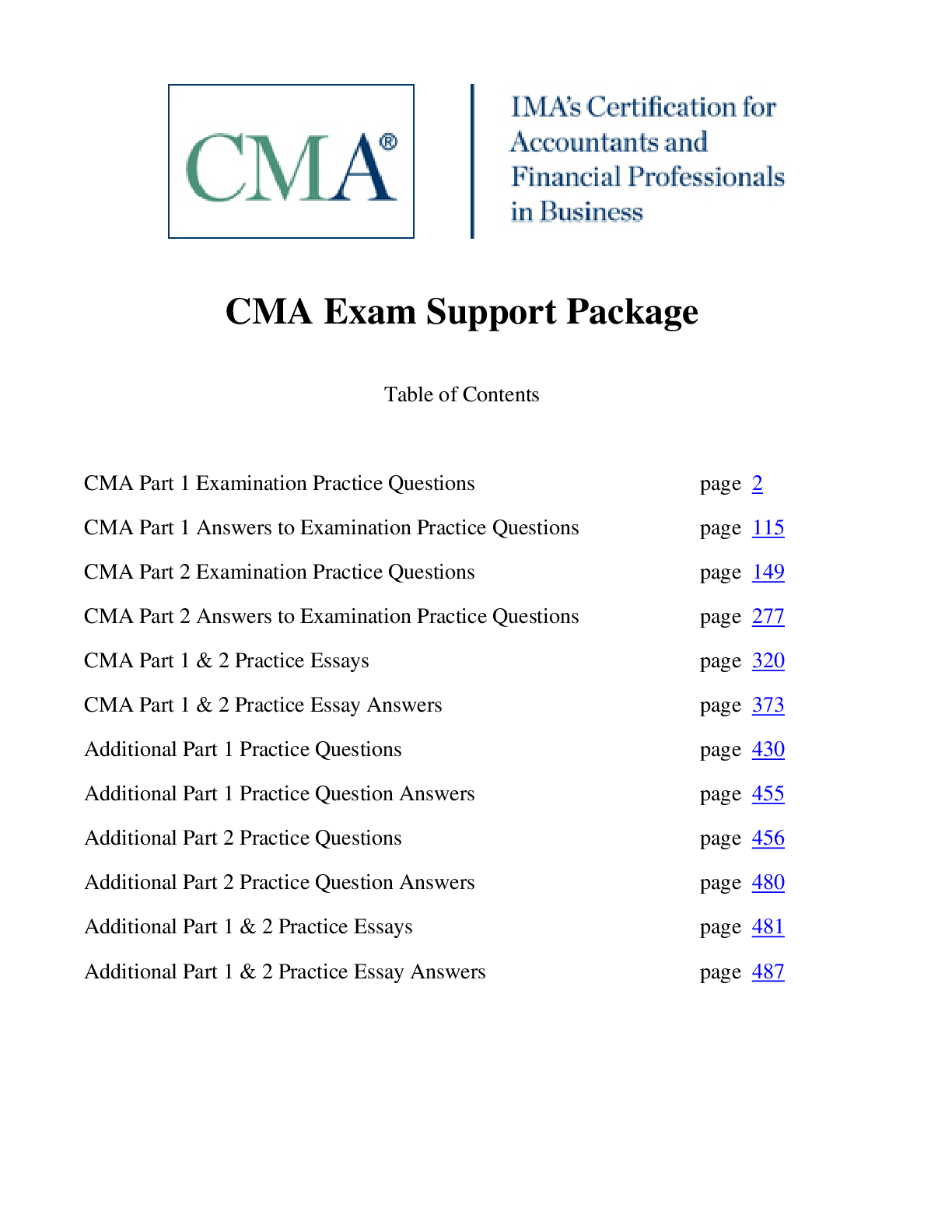*NURSING > TEST BANK > Pharmacology Exam Study Guide Test Bank_Complete Latest 2020|Keiser University - NURSING 1140 Pharm (All)
Pharmacology Exam Study Guide Test Bank_Complete Latest 2020|Keiser University - NURSING 1140 Pharm Exam study guide.
Document Content and Description Below
Pharmacology Exam Study Guide Test Bank_Complete Latest 2020|Keiser University - NURSING 1140 Pharm Exam study guide-72 beats per minute and regular. The nurse evaluates which situation in the patient... ’s peripheral nervous system? Standard Text: Select all that apply. 1. The sympathetic system is in control. 2. The parasympathetic system is dominating. 3. Both parasympathetic and sympathetic systems are influencing cardiac status. 4. The autonomic nervous system is affecting cardiac status. 5. The somatic nervous system is affecting cardiac status. Correct Answer: 2,3,4 Rationale 2: Restful cardiac response indicates that the primary input is from the parasympathetic system. Rationale 3: These two systems work in tandem to regulate the cardiac response. Rationale 4: Both the sympathetic and parasympathetic systems are part of the autonomic system. 2. A nurse is reading about the development of drugs that inhibit the parasympathetic nervous system. The nurse would look for articles about which drug classes? Standard Text: Select all that apply. 1. Anticholinergics 2. Parasympathomimetics 3. Parasympatholytics 4. Cholinergics 5. Muscarinic blockers Correct Answer: 1,3,5 Rationale 1: Anticholinergics inhibit the parasympathetic nervous system. Rationale 3: Parasympatholytic drugs inhibit the parasympathetic nervous system. Rationale 5: Muscarinic blockers inhibit the parasympathetic nervous system.Question 3 Type: Hot Spot Mark the site of the ganglionic synapse on this diagram. 1. A 2. B 3. C 4. D Answer: 3 Rationale: The ganglionic synapse is the gap between the preganglionic neuron and the postganglionic neuron. Question 4 Type: MCMA A patient has been prescribed an oral drug containing atropine. The nurse would hold the drug and Contact the prescriber if which patient statements are made? Standard Text: Select all that apply. 1. “I would like to wait a few minutes to take this as I just drank some aloe juice.” 2. “Can I take this at the same time as my procainamide?” 3. “I have had a headache this morning.” 4. “I am allergic to penicillin.”5. “My gallbladder surgery is scheduled for next week.” Correct Answer: 1,2 Rationale 1: Atropine should be used with caution in those who use aloe. Rationale 2: There is a drug–drug interaction between atropine and procainamide. Question 5 Type: MCSA The nurse has completed medication education about pyridostigmine (Mestinon), an indirect cholinergic drug, for the patient with myasthenia gravis. The nurse determines that learning has occurred when the patient makes which statement? 1. "My heart may beat slower while I am on this drug." 2. "I will need to increase my fluid intake with this medication." 3. "I must take this medication immediately before eating a full meal." 4. "It is really important to take my medication on time." Correct Answer: 4 Rationale 4: Maintaining an optimum blood level of the drug is crucial in promoting muscle functioning, so it is important for the patient to take his medication on time and as directed. Question 6 Type: MCSA The physician has ordered bethanechol (Urecholine), a cholinergic drug, for the patient with urinary retention. The patient also has an enlarged prostate gland. What is the priority action by the nurse? 1. Hold the drug and prepare to catheterize the patient. 2. Administer the drug and measure urinary output. 3. Administer the drug and push fluids. 4. Hold the drug and contact the physician. Correct Answer: 4. Rationale 4: Bethanechol (Urecholine) relaxes the urinary sphincter and increases voiding pressure. It is contraindicated with any physical obstruction of the urinary tract, such as an enlarged prostate gland.Question 7 Type: MCSA The preop patient will be receiving glycopyrrolate (Robinul), an anticholinergic drug, and asks the nurse, "Why do I need to have that shot?" What is the best response by the nurse? 1. "It will decrease your respiratory secretions during surgery." 2. "It will increase your urinary output during surgery." 3. "It will help you breathe better during surgery." 4. "It will help maintain your blood pressure during surgery." Correct Answer: 1 Rationale 1: Anticholinergics dry secretions; a decrease in respiratory secretions is indicated prior to surgery. Question 8 Type: MCSA The nurse is preparing to administer medications to a group of patients. One of the medications is benztropine (Cogentin), an anticholinergic drug. This drug is contraindicated in which patient? 1. The patient with a fractured femur 2. The patient with tachycardia 3. The patient with an irritable colon 4. The patient with diarrhea Correct Answer: 2 Rationale 2: Anticholinergic drugs increase the heart rate; a patient with tachycardia should not receive benztropine (Cogentin). Question 9 Type: MCSA The nurse is preparing to administer medications to a group of patients. One of the medications is atropine, an anticholinergic drug. This drug is contraindicated in which patient? 1. The patient with glaucoma2. The patient with hyperthyroidism 3. The patient with a hiatal hernia 4. The patient with lung cancer Correct Answer: 1 Rationale 1: Anticholinergic drugs can increase pressure in the eye; they must be avoided in patients with glaucoma. Question 10 Type: MCSA The physician orders dicyclomine (Bentyl), an anticholinergic drug, for a patient. What is the nurse's priority assessment prior to administering this drug? 1. Does the patient have light sensitivity? 2. Is the patient able to urinate? 3. Does the patient have a history of alcoholism? 4. Is the patient dizzy upon standing? Correct Answer: 2. Rationale 2: Anticholinergic drugs can cause or increase urinary hesitancy or retention. Question 11 Type: MCSA The patient is quadriplegic and receives oxybutynin (Ditropan), an anticholinergic drug, to increase his bladder capacity. What is an important assessment of this patient by the nurse? 1. Is he irritable? 2. Is he constipated? 3. Is he gaining weight? 4. Is he lethargic? Correct Answer: 2. Rationale 2: Anticholinergics slow gastrointestinal (GI) motility and can increase the risk for constipation. Question 12Type: MCMA The nursing instructor teaches the student nurses about the nervous system. The instructor determines that learning has occurred when the students make which statement(s)? Standard Text: Select all that apply. 1. "The central nervous system includes the brain and spinal cord." 2. "The peripheral nervous system has mainly sensory functions." 3. "The somatic nervous system gives us voluntary control over our gastrointestinal (GI) tract." 4. "The nervous system helps us react to environmental changes." 5. "The somatic nervous system gives us voluntary control over moving." Correct Answer: 1,4,5 Rationale 1: The central nervous system includes the brain and spinal cord. Rationale 4: The nervous system provides reaction to environmental changes. Rationale 5: The somatic nervous system provides voluntary control over moving. Question 13 Type: MCMA The nursing instructor teaches the student nurses about the autonomic nervous system. The instructor determines that learning has occurred when the students make which statement(s)? Standard Text: Select all that apply. 1. "The sympathetic and parasympathetic systems are not always opposite in their effects." 2. "The parasympathetic nervous system is the "fight-or-flight" response." 3. "Sympathetic stimulation causes dilation of arterioles." 4. "The parasympathetic nervous system causes bronchial constriction." 5. "The sympathetic nervous system is activated under stress." Correct Answer: 1,4,5 Rationale 1: The sympathetic and parasympathetic systems are not always opposite in their effects. Rationale 4: The parasympathetic nervous system causes bronchial constriction.Rationale 5: The sympathetic nervous system is activated under stress. Question 14 Type: MCSA The student nurse asks the nursing instructor, "Do the medications we are studying actually make more neurotransmitters?" What is the best response by the nursing instructor? 1. "No, but medications can heal diseases of the autonomic nervous system." 2. "Yes, some of the newer medications are very good at doing this." 3. "Yes, but the newer drugs that do this have some serious side effects." 4. "No, medications can only increase or decrease the action of neurotransmitters." Correct Answer: 4 Rationale 4: Medications cannot manufacture new neurotransmitters; they can only increase or decrease their action. Question 15 Type: MCSA The ability of a person to use his arm muscles to lift a weight is primarily regulated by 1. the somatic nervous system. 2. the sympathetic nervous system. 3. the autonomic nervous system. 4. the parasympathetic nervous system. Correct Answer: 1 Rationale 1: The somatic nervous system (a division of the peripheral nervous system) controls voluntary movement such as lifting a weight. Question 16 Type: MCSA Which of the following responses are regulated by the sympathetic nervous system? 1. Increased heart rate, bronchial constriction 2. Peripheral artery dilation, reduced peristalsis3. Increased secretions, sex organ stimulation 4. Relaxation of bladder, pupil dilation Correct Answer: 4 Rationale 4: Relaxation of the bladder and pupil dilation is regulated by the sympathetic nervous system. Question 17 Type: MCSA A person who had her adrenergic receptors activated would experience 1. fight-or-flight effects. 2. rest-and-digest effects. 3. increased blood volume. 4. bronchial constriction. Correct Answer: 1 Rationale 1: Adrenergic receptors are found within the sympathetic nervous system. Sympathetic nervous system activation produces the fight-or-flight response. Question 18 Type: MCSA Which substance would inhibit the function of the autonomic nervous system? 1. Drugs that bind and then stimulate the postsynaptic neuron 2. Drugs that prohibit neurotransmitter reuptake 3. Drugs that increase neurotransmitter synthesis 4. Drugs that prevent the storage of neurotransmitter in vesicles Correct Answer: 4 Rationale 4: The more neurotransmitter available, the greater the function/stimulation of the autonomic nervous system. Question 19 Type: MCSAWhich cholinergic receptor type is found at the ganglionic synapse of both the sympathetic and parasympathetic nervous systems? 1. Alpha receptors 2. Muscarinic 3. Nicotinic 4. Beta receptors Correct Answer: 3. Rationale 3: Nicotinic receptors are found at the ganglionic synapse of both sympathetic and parasympathetic nervous systems. Question 20 Type: MCMA A patient is prescribed an anticholinergic drug. What discharge instructions should the nurse provide? Standard Text: Select all that apply. 1. Wear sunglasses in bright light. 2. Limit fluid intake. 3. Increase fiber intake. 4. Avoid hot showers. 5. Avoid milk and dairy products. Correct Answer: 1,3,4 Rationale 1: Anticholinergic drugs may cause photosensitivity. Rationale 3: Use of anticholinergics increases risk for constipation. Fiber intake should be increased. Rationale 4: Use of anticholinergics reduces ability of patients to sweat and self-regulate temperature. Hot environments, including hot showers and baths, should be avoided. Question 21 Type: MCSA Which statement is accurate regarding exogenous acetylcholine? 1. Acetylcholine has almost no therapeutic effects because it is rapidly destroyed once given. 2. Acetylcholine is broken down rapidly within the body, preventing it from producing adverse effects.3. Acetylcholine will cause the heart rate to increase and blood pressure to drop. 4. When given in small amounts, acetylcholine will produce profound parasympathetic effects. Correct Answer: 1 Rationale 1: Exogenous acetylcholine is not generally administered, because it is rapidly destroyed by the body. Question 22 Type: MCSA The nurse explains that atropine (Atropair) increases heart rate in which manner? 1. Blocking the beta receptors of the parasympathetic nervous system. 2. Directly stimulating the sympathetic nervous system. 3. Potentiating the effects of acetylcholine on nicotinic receptors. 4. Blocking the effects of acetylcholine by occupying muscarinic receptors. Correct Answer: 4 Rationale 4: Atropine is a cholinergic-blocking agent that occupies muscarinic receptors. Question 23 Type: MCMA Which patient situations are considered involuntary responses to autonomic nervous system control? Standard Text: Select all that apply. 1. Sweating when hot 2. Stepping over a chair to prevent falling 3. Complaining of nausea 4. Salivating at the smell of food 5. Breathing deeper when running Correct Answer: 1,4,5 Rationale 1: Sweating is an involuntary response that is controlled by the sympathetic nervous system. Rationale 2: Muscle movement is controlled by the somatic nervous system.Rationale 3: Complaining of nausea is a result of sensory neuron input and is not part of the autonomic system. Rationale 4: Salivation is involuntary and is controlled by the autonomic nervous system. Question 24 Type: MCMA A patient has sustained a large blood loss. During the assessment, the nurse realizes that which findings are under the control of the nervous system? Standard Text: Select all that apply. 1. Heart rate 2. Blood pressure 3. Pupil size 4. Bowel sounds 5. Fluid volume Correct Answer: 1,2,3,4 Rationale 1: The brain, spinal cord, and peripheral nerves act as a smoothly integrated whole to accomplish minute-to-minute changes in essential functions such as heart rate. Rationale 2: The brain, spinal cord, and peripheral nerves act as a smoothly integrated whole to accomplish minute-to-minute changes in essential functions such as blood pressure. Rationale 3: The brain, spinal cord, and peripheral nerves act as a smoothly integrated whole to accomplish minute-to-minute changes in essential functions such as pupil size. Rationale 4: The brain, spinal cord, and peripheral nerves act as a smoothly integrated whole to accomplish minute-to-minute changes in essential functions such as intestinal motility. Question 25 Type: MCMA The nurse is caring for a patient with multisystem organ failure. Which patient assessment findings are under the control of the sympathetic nervous system? Standard Text: Select all that apply. 1. Blood glucose level 210 mg/dL2. Blood pressure 180/90 mmHg 3. Extremities are cool 4. Respiratory rate 14 and regular 5. Hyperactive bowel sounds Correct Answer: 1,2,3 Rationale 1: Metabolic effects such as an increase in blood glucose are a sympathetic nervous system function. Rationale 2: The constriction and relaxation of arterioles are controlled entirely by the sympathetic nervous system. Rationale 3: The sympathetic nervous system controls release of epinephrine and norepinephrine, which result in peripheral vasoconstriction. Question 26 Type: MCMA A student nurse is learning about a medication that affects the autonomic nervous system. When instructing the student about the effects of this medication, the nurse will begin by explaining the basic unit of this system. What does this include? Standard Text: Select all that apply. 1. The preganglionic neuron 2. The postganglionic neuron 3. The synaptic cleft 4. Norepinephrine 5. Dopamine Correct Answer: 1,2,3 Rationale 1: The basic unit of the autonomic nervous system is a two-neuron chain. The first neuron, called the preganglionic neuron, originates in the central nervous system. Rationale 2: The preganglionic neuron connects with the second nerve in the autonomic nervous system two-neuron chain through the ganglia, which contains the postganglionic neuron. Rationale 3: Autonomic messages must cross the synaptic cleft.Question 27 Type: SEQ The nurse educator is reviewing the process of synaptic transmission following the sympathetic pathway. In which order will the nurse explain the steps of synaptic transmission? 1. Action potential encounters adrenergic receptors 2. Action potential encounters cholinergic receptors 3. Action potential travels across the preganglionic neuron 4. Action potential travels across the postganglionic neuron 5. Target tissue is reached. Standard Text: Click and drag the options below to move them up or down. Correct Answer: 3,2,4,1,5 Question 28 Type: MCMA A patient is prescribed a medication that will block muscarinic receptors. The nurse realizes that this medication has implications for which body systems? Standard Text: Select all that apply. 1. Eyes 2. Respiratory 3. Cardiac 4. Endocrine 5. Metabolic Correct Answer: 1,2,3 Rationale 1: Medications that block muscarinic receptors are used during ophthalmic procedures. Rationale 2: Medications that block muscarinic receptors are used in the pharmacologic treatment of asthma. Rationale 3: Medications that block muscarinic receptors are used in the pharmacologic treatment of bradycardia.Question 29 Type: MCMA A patient has been prescribed scopolamine (Transderm-Scop) for the prevention of motion sickness. The nurse should teach the patient to immediately report which adverse effects? Standard Text: Select all that apply. 1. Slow heart rate 2. Cardiac palpitations 3. Decreased urinary output 4. Development of tremors 5. Diarrhea Correct Answer: 2,3,4 Rationale 2: Dysrhythmia is an adverse effect of this drug. Rationale 3: Decreased urinary output is an adverse effect of this drug. Rationale 4: Tremors are an adverse effect of this drug. Question 30 Type: MCMA A patient who has myasthenia gravis (MG) presents to the emergency department with abrupt onset of increased muscle weakness and difficulty swallowing. An attempt to distinguish worsening of the MG symptoms from overdose of the patient’s prescribed anticholinergic is planned. What medications should the nurse obtain for use in this procedure? Standard Text: Select all that apply. 1. Donepezil (Aricept) 2. Pyridostigmine (Mestinon) 3. Neostigmine (Prostigmin) 4. Edrophonium (Edrophonium Injectable) 5. Atropine (Atropine Injectable) Correct Answer: 4,5Rationale 4: Edrophonium (Edrophonium Injectable) is given as a test dose. If muscular symptoms improve, the patient is having a myasthenic crisis. Rationale 5: Atropine (Atropine Injectable) is given if the test results in a cholinergic crisis. Chapter 13: Question 1 Type: MCSA The patient receives methyldopa (Aldomet), an adrenergic drug. The nurse determines that the patient is having side effects when the patient makes which statement? 1. "Will you check my pupils? I can't see very well at all." 2. "I am so thirsty; will you please bring me another pitcher of water?" 3. "I am so anxious; I really need to walk around the room." 4. "I feel so sleepy that I don't think I can eat my dinner." Correct Answer: 3.Rationale 3: Adrenergic drugs mimic the effect of the sympathetic nervous system (SNS). This can result in anxiety and restlessness. Question 2 Type: MCSA The patient receives metaproterenol (Alupent), an adrenergic drug. A consulting physician orders carteolol (Cartrol), a beta blocker. What best describes the nurse's assessment? 1. The patient is at risk for a hypertensive crisis. 2. The effects of metaproterenol (Alupent) will be decreased. 3. The drugs are compatible; there will not be any adverse effects. 4. The effects of metaproterenol (Alupent) will be increased. Correct Answer: 2.Rationale 2: Beta-adrenergic blockers block the receptors that are stimulated by adrenergic drugs; the effects of metaproterenol (Alupent) would be decreased. Question 3 Type: MCSA The nurse has been doing medication education for the patient receiving atenolol (Tenormin), a beta blocker. The nurse determines that learning has occurred when the patient makes which statement?1. "I need to take my pulse every day." 2. "If I have any side effects, I will stop the medication." 3. "I cannot take this drug if I develop glaucoma." 4. "I cannot continue to have my morning cup of coffee." Correct Answer: 1 Rationale 1: Beta blockers slow the heart rate; therefore, the patient must monitor his pulse every day. Question 4 Type: MCSA The physician ordered prazosin (Minipress), an alpha-adrenergic blocker, for the patient. The nurse plans to do medication education. What will the best plan of the nurse include? 1. Instruct the patient to not take OTC herbal preparations containing saw palmetto. 2. Instruct the patient to not take tub baths. 3. Instruct the patient to decrease his intake of sodium. 4. Instruct the patient to wear sunglasses when outdoors. Correct Answer: 1 Rationale 1: A hypotensive response may occur when saw palmetto is taken concurrently Question 5 A patient has been prescribed an alpha1 adrenergic agonist drug. The nurse would plan to monitor for effects from which organs? Note: Credit will be given only if all correct choices and no incorrect choices are selected. Standard Text: Select all that apply. 1. Kidneys 2. Eyes 3. Heart 4. Bowels 5. LungsCorrect Answer: 1,2,4,5 Rationale 1: Alpha1 receptors have potential to affect the renal system. Rationale 2: Alpha1 receptors result in dilation of the pupils. Rationale 4: Alpha1 receptors have potential to affect receptors in the gastrointestinal tract. Rationale 5: Alpha1 receptors have potential to affect receptors in the respiratory system. Question 6 A patient is prescribed a drug that activates alpha2 receptors. The nurse would plan care based on which physiological response? 1. Inhibition of norepinephrine release 2. Absence of monoamine oxidase 3. Increased lipolysis 4. Destruction of presynaptic nerve terminals Correct Answer: 1 Rationale 1: The action of alpha2 receptors is to inhibit release of norepinephrine. Question 7 A nurse is reviewing medical records for usage of drugs that are beta2 agonists. The nurse should start with the medical records of patients with which conditions? Note: Credit will be given only if all correct choices and no incorrect choices are selected. Standard Text: Select all that apply. 1. Heart failure 2. Asthma 3. COPD 4. Overactive bladder 5. Nasal congestion Correct Answer: 2,3 Rationale 2: Beta2 agonists are useful in the treatment of asthma.Rationale 3: Beta2 agonists are useful in the treatment of COPD. Question 9 A patient who is in heart failure is administered a beta1 agonist. The nurse would evaluate that the drug is effective if which changes occur? Note: Credit will be given only if all correct choices and no incorrect choices are selected. Standard Text: Select all that apply. 1. Heart rate increases 2. Pulse becomes stronger 3. Pupils dilate 4. Dysrhythmias dissipate 5. Blood pressure drops Correct Answer: 1,2 Rationale 1: One of the effects of beta1 agonists is to increase the heart rate. Rationale 2: One of the effects of beta1 agonists is to increase force of cardiac contraction, which would be felt as a stronger pulse. Question 10 A patient has been prescribed isoproterenol (Isuprel). The nurse plans care based on the drug’s stimulation of which receptors? Note: Credit will be given only if all correct choices and no incorrect choices are selected. Standard Text: Select all that apply. 1. Alpha1 2. Alpha2 3. Beta1 4. Beta2 5. Beta3 Correct Answer: 3,4 Rationale 3: Isoproterenol (Isuprel) is a nonselective drug that stimulates beta1 receptors.Rationale 4: Isoproterenol (Isuprel) is a nonselective drug that stimulates beta2 receptors. Question 11 Type: Hot Spot The nurse is providing discharge medication instruction to the family of a child who is severely allergic to peanuts. Mark the spot where the family or patient should inject epinephrine from an EpiPen should an allergic response occur. 1. A 2. B 3. C 4. D Answer: 4.Rationale: This drug should be injected into the thigh only. Question 12 A nurse is providing discharge medication instruction regarding use of injectable epinephrine (EpiPen). What information should the nurse include? Note: Credit will be given only if all correct choices and no incorrect choices are selected.Standard Text: Select all that apply. 1. If you need to use this pen, seek medical advice as follow-up. 2. You can dispose of a used EpiPen in your regular trash. 3. Keep an extra EpiPen on hand. 4. Store this device in your refrigerator. 5. Carry an EpiPen in your car’s glovebox. Correct Answer: 1,3 Rationale 1: If it is necessary to use the EpiPen, it is important to seek immediate follow-up by calling 911 or the provider. Rationale 3: It is recommended that the patient have an extra EpiPen on hand in case of emergency or failure of the original unit. Question 13 A patient has been prescribed phenylephrine (Neo-Synephrine) spray for nasal congestion. What information about adverse effects should the nurse provide in discharge teaching? Note: Credit will be given only if all correct choices and no incorrect choices are selected. Standard Text: Select all that apply. 1. “This drug may cause some stinging or burning in your nose.” 2. “You may notice that your nasal secretions take on a slightly orange tint.” 3. “You may feel like your blood pressure is low for the first few times you use this spray.” 4. “One of the major adverse effects of this drug is rebound congestion if it is used more than a few days.” 5. “Do not drink herbal teas while taking this medication.” Correct Answer: 1,4 Rationale 3: Intranasal medications, if used properly, should have little or no effect on blood pressure. Rationale 4: Rebound congestion is likely to occur if the drug is used for over 3–5 days. Question 14 Type: MCMAThe nurse is preparing to administer an adrenergic drug intravenously. What nursing actions should be planned? Note: Credit will be given only if all correct choices and no incorrect choices are selected. Standard Text: Select all that apply. 1. Give the drug as rapidly as possible by intravenous push. 2. Dilute the drug before administration. 3. Use an infusion pump to control rate of administration. 4. Monitor for blanching at the infusion site. 5. Advise the patient that a sweet taste may occur as the drug is being given. Correct Answer: 2,3,4 Rationale 2: These drugs should be diluted prior to administration. Rationale 3: Infusion of these drugs should be controlled via an infusion pump. Rationale 4: Blanching at the infusion site indicates probable extravasation. The drip should be stopped. Question 15 Type: MCMA A patient has been prescribed phenylephrine (Neo-Synephrine). Prior to administering this drug the nurse would review the patient’s medication history for presence of which drugs? Note: Credit will be given only if all correct choices and no incorrect choices are selected. Standard Text: Select all that apply. 1. MAO inhibitors 2. Tricyclic antidepressants 3. Iron supplements 4. Digoxin 5. Aspirin Correct Answer: 1,2,3,4Rationale 1: Concurrent use with MAO inhibitors may result in hypertensive crisis. Rationale 2: Tricyclic antidepressants can potentiate the effects of phenylephrine (Neo-Synephrine). Rationale 3: Iron supplements are incompatible with phenylephrine (Neo-Synephrine). Rationale 4: Dysrhythmias may occur when phenylephrine (Neo-Synephrine) and digoxin are used concurrently. Question 16 A patient who was recently prescribed an adrenergic drug says, “I am so nervous and I cannot sleep.” The nurse would ask which questions? Note: Credit will be given only if all correct choices and no incorrect choices are selected. Standard Text: Select all that apply. 1. “How much coffee do you drink?” 2. “Have you recently increased your intake of dairy products?” 3. “Do you eat chocolate?” 4. “When was the last time you ate pickled foods or aged cheese?” 5. “How much wine or other alcoholic beverages do you drink?” Correct Answer: 1,3 Rationale 1: The caffeine in coffee may cause excessive nervousness, insomnia, and tremors. Rationale 3: The caffeine in chocolate may cause excessive nervousness, insomnia, and tremors. Question 17 Type: MCMA A patient who has used an adrenergic nasal spray for 2 weeks complains that, “I am more stuffed up now than I was when I was sick.” What advise should the nurse provide? Note: Credit will be given only if all correct choices and no incorrect choices are selected. Standard Text: Select all that apply. 1. “You are having an allergic reaction to the nasal spray. Stop using it immediately.” 2. “You probably have developed a secondary infection.” 3. “Try increasing the amount of fluids you are drinking.”4. “Switch to a saline-based nasal spray.” 5. “Continue to use your current nasal spray until the congestion goes away.” Correct Answer: 3,4 Rationale 3: Increased oral fluids may help to thin secretions, making them easier to remove. Rationale 4: The patient is probably experiencing rebound congestion. Switching from the adrenergic spray to a saline spray will keep the mucosa moist and more comfortable until the effects of the adrenergic spray abate. Question 18 An older adult patient received an adrenergic eye drop to dilate the pupils for a retinal exam. What information should the nurse provide when discharging this patient? Note: Credit will be given only if all correct choices and no incorrect choices are selected. Standard Text: Select all that apply. 1. “Do not drive until the effects of the eye drops have worn off.” 2. “Wear sunglasses when in bright light.” 3. “You may be more comfortable in a darkened room.” 4. “You may experience burning in your eyes for a couple of days.” 5. “Do not eat or drink anything for at least an hour after discharge.” Correct Answer: 1,2,3 Rationale 1: Older adults may notice blurring of vision after receiving drops to dilate the eyes. The patient should not drive until vision is clear. Rationale 2: Photosensitivity is a common effect, and protective eyewear should be worn. Rationale 3: Photosensitivity is a common effect, and the patient may be more comfortable in a darkened room or with a soft cloth covering the eyes. Question 19 A patient has been prescribed an adrenergic nasal spray. What medication instruction should the nurse provide? Note: Credit will be given only if all correct choices and no incorrect choices are selected. Standard Text: Select all that apply.1. “Do not share this spray with anyone.” 2. “Sit upright while using this spray.” 3. “Only use this spray for 3–5 days.” 4. “Do not shake the bottle before using this spray.” 5. “Keep this spray refrigerated.” Correct Answer: 1,2,3 Rationale 1: Sharing nasal sprays may spread infection. Rationale 2: The patient should sit upright to use this medication so that it is delivered appropriately, avoiding overdosage. Rationale 3: Adrenergic nasal sprays may cause rebound congestion if used more that 3–5 days. Question 20 Type: MCSA Which statement is accurate concerning drugs classified as adrenergic antagonists? 1. They are also known as anticholinergics. 2. Their actions will block the neurotransmitter acetylcholine. 3. Their actions are the opposite of those of sympathomimetics. 4. They will stimulate the sympathetic nervous system. Correct Answer: 3.Rationale 3: Adrenergic antagonists inhibit the actions of the sympathetic nervous system. Question 21 During assessment a patient says, “I took my blood pressure at home and it was high. I have been taking my husband’s propranolol (Inderal) for the last week.” The nurse is especially concerned about this action when it is noted that the patient has which preexisting conditions? Note: Credit will be given only if all correct choices and no incorrect choices are selected. Standard Text: Select all that apply. 1. Obesity2. Diabetes mellitus 3. COPD 4. Asthma 5. Rheumatoid arthritis Correct Answer: 2,3,4 Rationale 2: Beta blockers may cause hyperglycemia or hypoglycemia and may mask the symptoms of hypoglycemia in patients with diabetes. Rationale 3: Beta blockers may cause significant bronchial constriction. Rationale 4: Beta blockers may cause significant bronchial constriction. Question 22 A patient states, “I stopped taking that beta blocker last week. It made me so tired, I just couldn’t go on taking it.” What are the priority nursing assessments? Note: Credit will be given only if all correct choices and no incorrect choices are selected. Standard Text: Select all that apply. 1. Blood pressure 2. Heart rhythm 3. Urinary output 4. Presence of chest pain 5. Presence of respiratory crackles Correct Answer: 1,2,4 Rationale 1: Abruptly discontinuing beta blockers may result in acute resurgence of symptoms such as hypertension. Rationale 2: Abruptly discontinuing beta blockers may result in acute resurgence of symptoms such as dysrhythmia. Rationale 4: Abruptly discontinuing beta blockers may result in chest pain. Question 23 A patient has been prescribed prazosin (Minipress). What information should the nurse provide?Note: Credit will be given only if all correct choices and no incorrect choices are selected. Standard Text: Select all that apply. 1. “Stay out of the sun until you determine if you become sun-sensitive.” 2. “Take this medication just before you go to bed.” 3. “This medication may make you dizzy.” 4. “This medication may slow your heart rate noticeably.” 5. “Do not take this medication with milk.” Correct Answer: 2,3 Rationale 2: This medication should be taken just before bedtime as it may cause drowsiness or lightheadedness. Rationale 3: Dizziness is a common adverse effect of this drug. Question 24 A patient who was administered prazosin (Minipress) became unconscious 30 minutes after the first dose. What medications should the nurse prepare for resuscitation? Note: Credit will be given only if all correct choices and no incorrect choices are selected. Standard Text: Select all that apply. 1. Normal saline 2. Dobutamine 3. Atenolol (Tenormin) 4. Carvedilol (Coreg) 5. Propranolol (Inderal) Correct Answer: 1,2 Rationale 1: Unconsciousness after the first dose of prazosin (Minipress) is typically due to severe hypotension. Normal saline can be used as a volume expander. Rationale 2: Unconsciousness after the first dose of prazosin (Minipress) is typically due to severe hypotension. Treatment with a vasopressor such as dobutamine may be indicated. Question 25Type: MCMA A patient has been prescribed an adrenergic-blocker for treatment of hypertension. What information should the nurse provide? Note: Credit will be given only if all correct choices and no incorrect choices are selected. Standard Text: Select all that apply. 1. “Rise from a sitting position slowly.” 2. “Sit on the side of the bed a few moments before you stand.” 3. “If you feel dizzy, add more salt to your diet.” 4. “If you feel dizzy, sit or lie down until the dizziness passes.” 5. “Try to continue daily activities even if dizziness occurs.” Correct Answer: 1,2,4 Rationale 1: Patients who are starting on adrenergic-blocking drugs should move slowly from the sitting position. Rationale 2: Sitting on the side of the bed will help blood pressure normalize before standing. Rationale 4: If the patient feels dizzy, sitting down or lying down will help to prevent falls. Question 26 A patient returns to the clinic for follow-up after taking an adrenergic blocking medication for benign prostatic hypertrophy (BPH.) What assessment questions should the nurse ask? Note: Credit will be given only if all correct choices and no incorrect choices are selected. Standard Text: Select all that apply. 1. “What color is your urine?” 2. “Do you have any difficulty starting to urinate?” 3. “Do you have the feeling that your bladder is full?” 4. “When was your last bowel movement?” 5. “Have you noticed being more hungry than usual?” Correct Answer: 2,3 Rationale 2: Adrenergic blockers may result in hesitancy.Rationale 3: Adrenergic blockers may result in retention of urine. Question 27 The nurse would classify which sympathomimetics as binding to and activating adrenergic receptors? Note: Credit will be given only if all correct choices and no incorrect choices are selected. Standard Text: Select all that apply. 1. Epinephrine 2. Dopamine 3. Amphetamine 4. Cocaine 5. Ephedrine Correct Answer: 1,2,5 Rationale 1: Epinephrine is an endogenous catecholamine that acts directly by binding to and activating adrenergic receptors. Rationale 2: Dopamine is an endogenous catecholamine that acts directly by binding to and activating adrenergic receptors. Rationale 5: Ephedrine acts both directly and indirectly. Question 28 A patient is being assessed for the presence of pheochromocytoma. The nurse would prepare for which interventions? Note: Credit will be given only if all correct choices and no incorrect choices are selected. Standard Text: Select all that apply. 1. Monitoring blood pressure 2. Monitoring bowel sounds 3. Administration of phentolamine (Regitine) 4. Rapid administration of normal saline 5. Urinary catheterization to bypass prostatic enlargement Correct Answer: 1,3Rationale 1: Pheochromocytoma affects blood pressure, so continuous monitoring is necessary. Rationale 3: Sudden and marked reduction of blood pressure results when a patient with pheochromocytoma is administered phentolamine (Regitine) parenterally. Question 29 Due to an administration error, a patient may have received too much phenylephrine (Neo-Synephrine). Which findings would support the nurse’s concerns about overdosage? Standard Text: Select all that apply. 1. The patient’s heart rate has increased from 72 bpm to 114 bpm. 2. The patient reports feeling anxious. 3. The patient’s blood pressure has increased from 140/86 mmHg to 180/98 mmHg. 4. The patient’s stools are dark and tarry. 5. The patient reports burning at the injection site. Correct Answer: 1,3 Rationale 1: An overdose of phenylephrine (Neo-Synephrine) will result in tachycardia. Rationale 3: Overdosage of phenylephrine (Neo-Synephrine) will result in hypertension. Question 30 A 48-year-old male patient tells the nurse, “I have stopped taking my prazosin (Minipress). I don’t like its effect on me.” The nurse should ask further assessment questions about which possible effects? Standard Text: Select all that apply. 1. Impotence 2. Nasal congestion 3. Somnolence 4. Nervousness 5. Slow heart rate Correct Answer: 1,2,3 Rationale 1: Some alpha blockers result in impotence or inhibition of ejaculation. Rationale 2: Nasal congestion is a common adverse effect of alpha blockade.Rationale 3: Drowsiness may occur with alpha blockers. Chapter 14: Question 1 Type: MCSA The patient tells the nurse he worries about everything all day, feels confused, restless, and just can't stop worrying. What is the best response by the nurse? 1. "You have generalized anxiety; I will teach you some relaxation techniques." 2. "This sounds like social anxiety. You need to calm down and you'll be fine." 3. "You have posttraumatic stress disorder (PTSD), and it is time for your therapy session." 4. "This is called panic disorder; I'll get your medication for you." Correct Answer: 1 Rationale 1: Generalized anxiety disorder is characterized by excessive anxiety but not to panic levels. Other symptoms include restlessness, muscle tension, and loss of focus and ability to concentrate. Relaxation techniques are effective in reducing anxiety. Rationale 2: Social anxiety disorder is characterized by "performance anxiety," (i.e., extreme fear when a patient is in a social situation); there is no information to support that this is what the patient is experiencing. Also, telling the patient to "calm down" is non-therapeutic. Rationale 3: Posttraumatic stress disorder is situational anxiety that develops in response to reexperiencing a previous traumatic life event; there is no information that the patient has experienced a trauma. Rationale 4: Panic disorder is characterized by intense feelings of apprehension, terror, and impending doom and increased autonomic nervous system anxiety; the patient does not have these symptoms. Global Rationale: Generalized anxiety disorder is characterized by excessive anxiety but not to panic levels. Other symptoms include restlessness, muscle tension, and loss of focus and ability to concentrate. Relaxation techniques are effective in reducing anxiety. Panic disorder is characterized by intense feelings of apprehension, terror, and impending doom and increased autonomic nervous system anxiety; the patient does not have these symptoms. Posttraumatic stress disorder is situational anxiety that develops in response to re-experiencing a previous traumatic life event; there is no information that the patient has experienced a trauma. Social anxiety disorder is characterized by "performance anxiety," (i.e., extreme fear when a patient is in a social situation); there is no information to support that this is what the patient is experiencing. Also, telling the patient to "calm down" is non-therapeutic.Cognitive Level: Applying Client Need: Psychosocial Integrity Client Need Sub: QSEN Competencies: III.A.1 Demonstrate knowledge of basic scientific methods and processes. AACN Essentials Competencies: III.1 Explain the interrelationships among theory, practice, and research. NLN Competencies: Knowledge and Science: Relationships between knowledge and science and quality and safe patient care. Nursing/Integrated Concepts: Nursing Process: Implementation Learning Outcome: 14-1 Identify the major types of anxiety disorders. MNL Learning Outcome: 3.4.1 Examine the etiology, pathophysiology and clinical manifestations. Page Number: 162 Question 2 Type: MCMA The nurse has completed group education for patients with anxiety disorders. The education is evaluated as successful when the patients make which statements? Note: Credit will be given only if all correct choices and no incorrect choices are selected. Standard Text: Select all that apply. 1. "Relaxation techniques will often decrease anxiety." 2. "Antianxiety medicine should be used until anxiety is gone." 3. "Antianxiety medicine should not be used indefinitely." 4. "Therapy may help identify where this anxiety comes from." 5. "Different medications are required for treating anxiety than for treating difficulty sleeping." Correct Answer: 1,3,4Rationale 1: Nonpharmacological techniques such as relaxation techniques are effective in reducing some levels of anxiety. Rationale 2: Absence of anxiety is an unrealistic goal because all individuals will have some level of anxiety during their lifetime. Rationale 3: For most patients, anti-anxiety medication is intended for short-term use. Rationale 4: Patients with anxiety disorders should be encouraged to uncover the cause of the anxiety through cognitive-behavioral therapy or other counseling techniques. Rationale 5: Often, the same medication can be used for anxiety as well as insomnia. Global Rationale: Patients with anxiety disorders should be encouraged to uncover the cause of the anxiety through cognitive-behavioral therapy or other counseling techniques. Nonpharmacological techniques such as relaxation techniques are effective in reducing some levels of anxiety. For most patients, anti-anxiety medication is intended for short-term use. Absence of anxiety is an unrealistic goal because all individuals will have some level of anxiety during their lifetime. Often, the same medication can be used for anxiety as well as insomnia. Cognitive Level: Analyzing Client Need: Psychosocial Integrity Client Need Sub: QSEN Competencies: I.B.3 Provide patient-centered care with sensitivity and respect for the diversity of human experience. AACN Essentials Competencies: VII.4 Use behavioral change techniques to promote health and manage illness. NLN Competencies: Knowledge and Science: Relationships between knowledge and science and quality and safe patient care. Nursing/Integrated Concepts: Nursing Process: Evaluation Learning Outcome: 14-3 Discuss factors contributing to anxiety and explain some nonpharmacologic therapies used to cope with this disorder. MNL Learning Outcome: 3.4.1 Examine the etiology, pathophysiology and clinical manifestations. Page Number: 164Question 3 Type: MCSA The patient tells the nurse that she is interested in the human brain and questions which parts of the brain control anxiety and insomnia. What is the best reply by the nurse? 1. "The limbic system and reticular activating system control anxiety and insomnia." 2. "The frontal lobes and limbic system control anxiety and insomnia." 3. "The thalamus and reticular activating system control anxiety and insomnia." 4. "The limbic system and hypothalamus control anxiety and insomnia." Correct Answer: 1 Rationale 1: Neural systems associated with anxiety and restlessness include the limbic system and the reticular activating system. The reticular activating system is responsible for sleeping and wakefulness and performs an alerting function for the entire cerebral cortex. Rationale 2: The frontal lobes are not responsible for anxiety and sleep. Rationale 3: The thalamus is not responsible for anxiety and sleep. Rationale 4: The hypothalamus is not responsible for anxiety and sleep. Global Rationale: Neural systems associated with anxiety and restlessness include the limbic system and the reticular activating system. The reticular activating system is responsible for sleeping and wakefulness and performs an alerting function for the entire cerebral cortex. The limbic system and the reticular activating system, not the hypothalamus, are responsible for anxiety and sleep. The limbic system and the reticular activating system, not the frontal lobes, are responsible for anxiety and sleep. The limbic system and the reticular activating system, not the thalamus, are responsible for anxiety and sleep. Cognitive Level: Applying Client Need: Psychosocial Integrity Client Need Sub: QSEN Competencies: III.A.1 Demonstrate knowledge of basic scientific methods and processes. AACN Essentials Competencies: I.2 Synthesize theories and concepts from liberal education to build an understanding of the human experience.NLN Competencies: Knowledge and Science: Relationships between knowledge and science and quality and safe patient care. Nursing/Integrated Concepts: Nursing Process: Implementation Learning Outcome: 14-2 Identify the regions of the brain associated with anxiety, sleep, and wakefulness. MNL Learning Outcome: 3.4.1 Examine the etiology, pathophysiology and clinical manifestations. Page Number: 162 Question 4 Type: MCMA The patient tells the nurse, "I am really confused after talking to my doctor. He said I would be taking different kinds of medications for my anxiety and insomnia. Will you please explain it?" What is the best response by the nurse? Note: Credit will be given only if all correct choices and no incorrect choices are selected. Standard Text: Select all that apply. 1. "You will be taking medications known as sedative-hypnotics." 2. "You will be taking medications known as antidepressants." 3. "You will be taking a medication known as paraldehyde." 4. "You will be taking medications known as barbiturates." 5. "You will be taking medications known as benzodiazepines." Correct Answer: 1,2,5 Rationale 1: The three categories of medications used to treat anxiety and sleep disorders include the sedative-hypnotics. Rationale 2: The three categories of medications used to treat anxiety and sleep disorders include the antidepressants. Rationale 3: Paraldehyde is no longer used for anxiety or insomnia because of significant side effects and the availability of more effective medications. Rationale 4: Barbiturates are no longer used for anxiety or insomnia because of significant side effects and the availability of more effective medications.Rationale 5: The three categories of medications used to treat anxiety and sleep disorders include the benzodiazepines. Global Rationale: The three categories of medications used to treat anxiety and sleep disorders include the benzodiazepines, antidepressants, and sedative-hypnotics. Barbiturates are no longer used for anxiety or insomnia because of significant side effects and the availability of more effective medications. Paraldehyde is no longer used for anxiety or insomnia because of significant side effects and the availability of more effective medications. Cognitive Level: Applying Client Need: Psychosocial Integrity Client Need Sub: QSEN Competencies: III.A.1 Demonstrate knowledge of basic scientific methods and processes. AACN Essentials Competencies: III.1 Explain the interrelationships among theory, practice, and research. NLN Competencies: Knowledge and Science: Relationships between knowledge and science and quality and safe patient care. Nursing/Integrated Concepts: Nursing Process: Implementation Learning Outcome: 14-4 Identify the three classes of medications used to treat anxiety and sleep disorders. MNL Learning Outcome: 3.4.2 Compare the classes of medication used in pharmacologic management. Page Number: 167 Question 5 Type: MCSA The patient has generalized anxiety disorder. He asks the nurse, "Will I need medication for this? My neighbor is very nervous and he takes medication." What is the best response by the nurse? 1. "Medications are a way of life for patients with anxiety disorders." 2. "Medication is necessary initially; later we will try therapy." 3. "Probably not, but you shouldn't compare yourself to your neighbor."4. "Medication is necessary when anxiety interferes with your quality of life." Correct Answer: 4 Rationale 1: Medications are not considered "a way of life" for patients with anxiety disorders; many patients can manage anxiety without medications. Rationale 2: Medication combined with therapy is considered the best approach for treatment of anxiety disorders. Rationale 3: The nurse does not have enough information to tell the patient that medications will probably not be necessary. Rationale 4: It is more productive to identify and treat the cause of anxiety than to use medications. When anxiety becomes severe enough to significantly interfere with the patient's quality of life, pharmacotherapy is indicated. Global Rationale: It is more productive to identify and treat the cause of anxiety than to use medications. When anxiety becomes severe enough to significantly interfere with the patient's quality of life, pharmacotherapy is indicated. Medications are not considered "a way of life" for patients with anxiety disorders; many patients can manage anxiety without medications. The nurse does not have enough information to tell the patient that medications will probably not be necessary. Medication combined with therapy is considered the best approach for treatment of anxiety disorders. Cognitive Level: Applying Client Need: Psychosocial Integrity Client Need Sub: QSEN Competencies: III.A.1 Demonstrate knowledge of basic scientific methods and processes. AACN Essentials Competencies: III.1 Explain the interrelationships among theory, practice, and research. NLN Competencies: Knowledge and Science: Relationships between knowledge and science and quality and safe patient care. Nursing/Integrated Concepts: Nursing Process: Implementation Learning Outcome: 14-5 Explain the pharmacologic management of anxiety and insomnia. MNL Learning Outcome: 3.4.3 Apply the nursing process to pharmacotherapy, safe drug administration, and client education. Page Number: 164Question 6 Type: MCSA The patient has been treated by the same physician for 2 years and has had insomnia the entire time. Many different medications have been tried with limited success. What should be the nurse's primary assessment at this time? 1. Assess for a primary sleep disorder such as sleep apnea. 2. Assess if the patient has been selling his medications to addicts. 3. Assess if the patient has an addictive personality disorder. 4. Assess the patient for a primary personality disorder. Correct Answer: 1 Rationale 1: If the patient has a primary sleep disorder such as sleep apnea, this must be treated to relieve the insomnia. Also, medications such as benzodiazepines depress respiratory drive and would aggravate the sleep apnea. Rationale 2: While it is remotely possible that the patient is selling his medication, it is not likely for a patient with an anxiety disorder to do this. Rationale 3: There is no information that the patient might have an addictive personality disorder. If he did, the nurse would know this after 2 years of treatment. Rationale 4: There is no information that the patient might have a personality disorder. If he did, the nurse would most likely recognize this after 2 years of treatment. Global Rationale: If the patient has a primary sleep disorder such as sleep apnea, this must be treated to relieve the insomnia. Also, medications such as benzodiazepines depress respiratory drive and would aggravate the sleep apnea. There is no information that the patient might have a personality disorder. If he did, the nurse would most likely recognize this after 2 years of treatment. While it is remotely possible that the patient is selling his medication; it is not likely for a patient with an anxiety disorder to do this. There is no information that the patient might have an addictive personality disorder. If he did, the nurse would know this after 2 years of treatment. Cognitive Level: Applying Client Need: Psychosocial Integrity Client Need Sub:QSEN Competencies: III.A.1 Demonstrate knowledge of basic scientific methods and processes. AACN Essentials Competencies: III.2 Demonstrate an understanding of the basic elements of the research process and models or applying evidence to clinical practice. NLN Competencies: Knowledge and Science: Relationships between knowledge and science and quality and safe patient care. Nursing/Integrated Concepts: Nursing Process: Assessment Learning Outcome: 14-7 Identify normal sleep patterns and explain how these might be affected by anxiety and stress. MNL Learning Outcome: 3.4.1 Examine the etiology, pathophysiology and clinical manifestations. Page Number: 165 Question 7 Type: MCSA The patient is scheduled to have an EEG to confirm the presence of a sleep disorder. The patient asks the nurse to describe NREM stage 3 sleep. What is the best response by the nurse? 1. "This is the lightest stage of sleep and is profoundly affected by anxiety." 2. "Dreaming occurs here; without dreams you will be irritable and paranoid." 3. "This is the deepest stage of sleep; without it you will be tired and depressed." 4. "This is the also called paradoxical sleep." Correct Answer: 3 Rationale 1: NREM stage 3 sleep is the deepest stage of sleep. Patients who are deprived of it experience depression and a feeling of apathy and fatigue. Rationale 2: Dreaming occurs in REM sleep, not NREM sleep. Rationale 3: NREM stage 3 is not the lightest stage of sleep. Rationale 4: REM sleep is often called paradoxical sleep.Global Rationale: NREM stage 3 sleep is the deepest stage of sleep. Patients who are deprived of it experience depression and feelings of apathy and fatigue. Dreaming occurs in REM sleep, not NREM sleep. NREM stage 3 is not the lightest stage of sleep. REM sleep is often called paradoxical sleep. Cognitive Level: Applying Client Need: Psychosocial Integrity Client Need Sub: QSEN Competencies: III.A.1 Demonstrate knowledge of basic scientific methods and processes. AACN Essentials Competencies: III.2 Demonstrate an understanding of the basic elements of the research process and models or applying evidence to clinical practice. NLN Competencies: Knowledge and Science: Relationships between knowledge and science and quality and safe patient care. Nursing/Integrated Concepts: Nursing Process: Implementation Learning Outcome: 14-7 Identify normal sleep patterns and explain how these might be affected by anxiety and stress. MNL Learning Outcome: 3.4.1 Examine the etiology, pathophysiology and clinical manifestations. Page Number: 166 Question 8 Type: MCSA The patient has been taking lorazepam (Ativan) for 2 years. The patient stopped this medication after a neighbor said the drug manufacturer's plant was contaminated with rat droppings. What best describes the nurse's assessment of the patient when seen 3 days after stopping his medication? 1. Increased heart rate, fever, and muscle cramps 2. Nothing different; it is safe to abruptly stop lorazepam (Ativan) 3. Pinpoint pupils, constipation, and urinary retention4. A sense of calmness and lack of anxiety Correct Answer: 1 Rationale 1: Many central nervous system (CNS) depressants can cause physical and psychological dependence. The withdrawal syndrome for some central nervous system (CNS) depressants can include fever, seizures, increased pulse, anorexia, muscle cramps, disorientation, etc. Rationale 2: It is not safe to abruptly stop lorazepam (Ativan); withdrawal symptoms will occur. Rationale 3: Pinpoint pupils, constipation, and urinary retention are signs of opioid use. Rationale 4: The patient would be anxious, not calm, during benzodiazepine withdrawal. Global Rationale: Many central nervous system (CNS) depressants can cause physical and psychological dependence. The withdrawal syndrome for some central nervous system (CNS) depressants can include fever, seizures, increased pulse, anorexia, muscle cramps, disorientation, etc. It is not safe to abruptly stop lorazepam (Ativan); withdrawal symptoms will occur. Pinpoint pupils, constipation, and urinary retention are signs of opioid use. The patient would be anxious, not calm, during benzodiazepine withdrawal. Cognitive Level: Applying Client Need: Physiological Integrity Client Need Sub: Pharmacological and Parenteral Therapies QSEN Competencies: III.A.1 Demonstrate knowledge of basic scientific methods and processes. AACN Essentials Competencies: III.1 Explain the interrelationships among theory, practice, and research. NLN Competencies: Knowledge and Science: Relationships between knowledge and science and quality and safe patient care. Nursing/Integrated Concepts: Nursing Process: Implementation Learning Outcome: 14-5 Explain the pharmacologic management of anxiety and insomnia. MNL Learning Outcome: 3.4.3 Apply the nursing process to pharmacotherapy, safe drug administration, and client education. Page Number: 167Question 9 Type: MCSA The patient comes to the emergency department after an overdose of lorazepam (Ativan). The nurse will plan to administer which medication? 1. Pralidoxime (Protopam) 2. Naloxone (Narcan) 3. Flumazenil (Romazicon) 4. Nalmefene (Revex) Correct Answer: 3 Rationale 1: Pralidoxime (Protopam) is indicated for treatment of organophosphate poisoning. Rationale 2: Naloxone (Narcan) is indicated for treatment of opiate overdose. Rationale 3: Should an overdose of benzodiazepines occur, flumazenil (Romazicon) is a specific benzodiazepine receptor antagonist that can be administered to reverse central nervous system (CNS) depression. Rationale 4: Nalmefene (Revex) is indicated for treatment of opiate overdose. Global Rationale: Should an overdose of benzodiazepines occur, flumazenil (Romazicon) is a specific benzodiazepine receptor antagonist that can be administered to reverse central nervous system (CNS) depression. Naloxone (Narcan) is indicated for treatment of opiate overdose. Nalmefene (Revex) is indicated for treatment of opiate overdose. Pralidoxime (Protopam) is indicated for treatment of organophosphate poisoning. Cognitive Level: Applying Client Need: Physiological Integrity Client Need Sub: Pharmacological and Parenteral Therapies QSEN Competencies: V.A.4 Delineate general categories of errors and hazards in care. AACN Essentials Competencies: IX.3 Implement holistic, patient-centered care that reflects an understanding of human growth and development, pathophysiology, pharmacology, medical management, and nursing management across the health-illness continuum, across lifespan, and in all healthcare settings.NLN Competencies: Knowledge and Science: Relationships between knowledge and science and quality and safe patient care. Nursing/Integrated Concepts: Nursing Process: Planning Learning Outcome: 14-9 For each of the drug classes listed in Drugs at a Glance, know representative drugs and explain their mechanisms of action, primary actions, and important adverse effects. MNL Learning Outcome: 3.4. 2 Compare the classes of medications used in pharmacological management. Page Number: 171 Question 10 Type: MCSA The nurse works with a physician who frequently prescribes benzodiazepines. The use of benzodiazepines in which patient would cause the nurse the most concern? 1. An 87-year-old patient who uses a cane for ambulation 2. A 9-year-old child with panic attacks 3. A 42-year-old businessman who travels internationally 4. A 32-year-old mother of two preschool children Correct Answer: 1 Rationale 1: Benzodiazepines should be used with caution in older adults due to their adverse effects of drowsiness and sedation. This puts older adults at risk of falls. Rationale 2: Benzodiazepines must be used with caution in children, but these patients are not at as high risk as older adults. Rationale 3: There is minimal concern with benzodiazepine use in a 42-year-old patient. Rationale 4: There is minimal concern with benzodiazepine use in a 32-year-old patient. Global Rationale: Benzodiazepines should be used with caution in older adults due to their adverse effects of drowsiness and sedation. This puts older adults at risk for falls. There have been few studies of benzodiazepine use in the pediatric population; benzodiazepines must be used with caution, but these patients are not at as high risk as the elderly population. There is minimal concern with benzodiazepine use in a 32-year-old patient. There is minimal concern with benzodiazepine use in a 42-year-old patient.Cognitive Level: Analyzing Client Need: Physiological Integrity Client Need Sub: Pharmacological and Parenteral Therapies QSEN Competencies: I.B.15 Communicate care provided and needed at each transition of care. AACN Essentials Competencies: IX.8 Implement evidence-based nursing interventions as appropriate for managing the acute and chronic care of patients and promoting health across the lifespan. NLN Competencies: Knowledge and Science: Relationships between knowledge and science and quality and safe patient care. Nursing/Integrated Concepts: Nursing Process: Assessment Learning Outcome: 14-6 Describe the nurse’s role in the pharmacologic management of anxiety and insomnia. MNL Learning Outcome: 3.4.3 Apply the nursing process to pharmacotherapy, safe drug administration, and client education. Page Number: 171 Question 11 Type: MCSA The nurse has completed medication education for the anxious patient who is receiving buspirone (BuSpar). The nurse determines that the patient needs additional instruction when the patient makes which statement? 1. "Side effects I might experience include dizziness, headache, and drowsiness." 2. "I can take this medication when I feel anxious and it will relax me." 3. "I have to take this medicine on a regular basis for it to help me." 4. "I don't need to worry about becoming dependent on this medication." Correct [Show More]
Last updated: 11 months ago
Preview 1 out of 339 pages
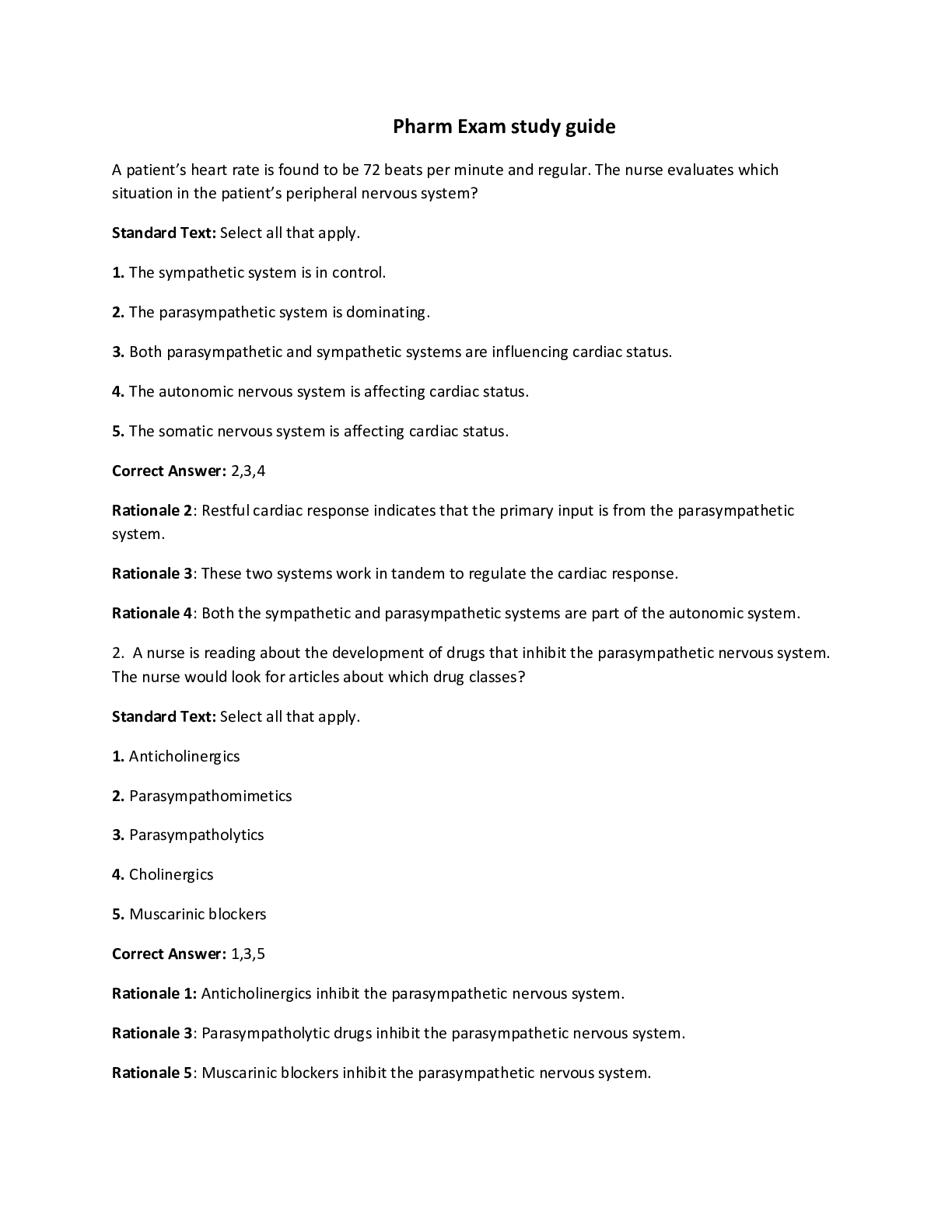
Reviews( 0 )
Document information
Connected school, study & course
About the document
Uploaded On
Mar 04, 2022
Number of pages
339
Written in
Additional information
This document has been written for:
Uploaded
Mar 04, 2022
Downloads
0
Views
52

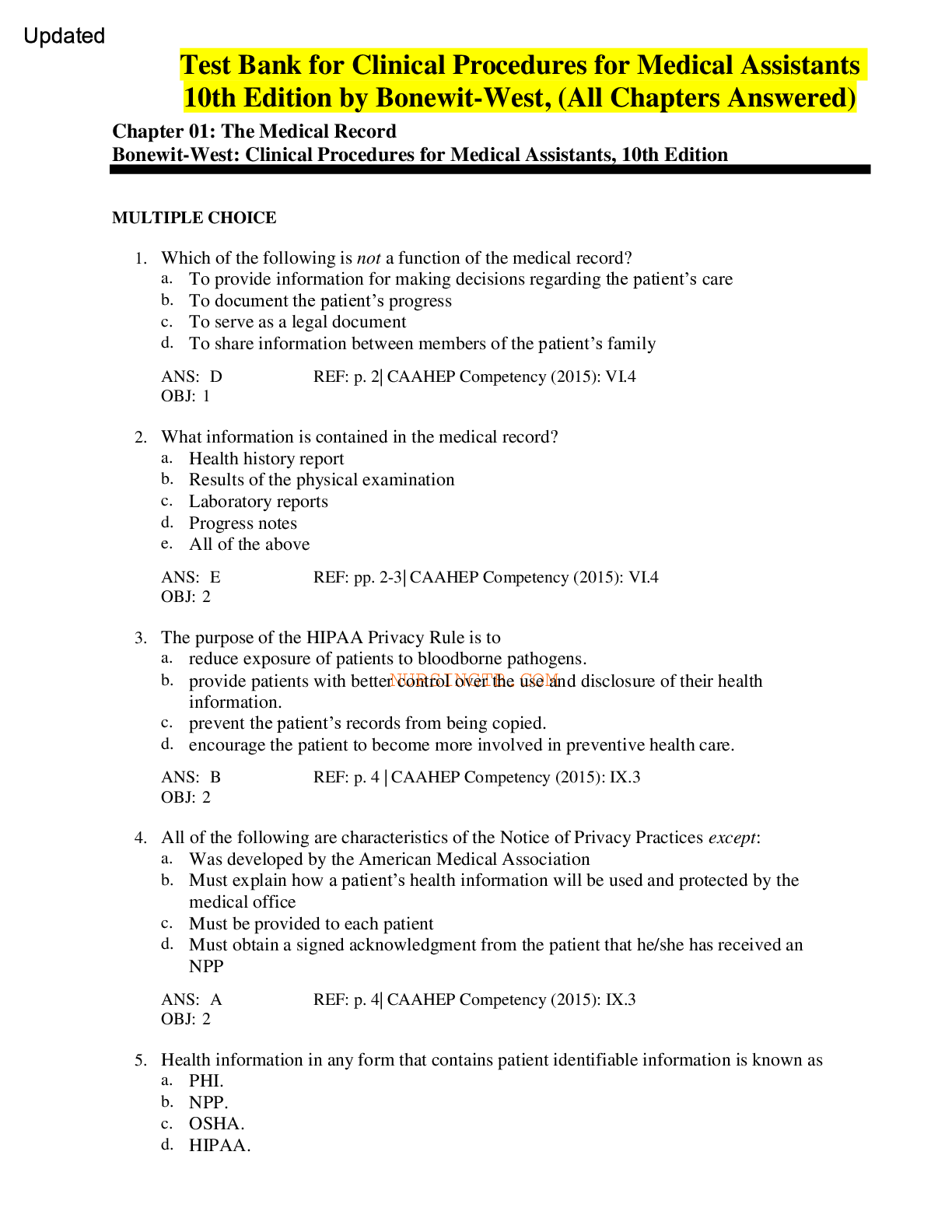
 Including NCLEX Exam Q&As With Rationales.png)
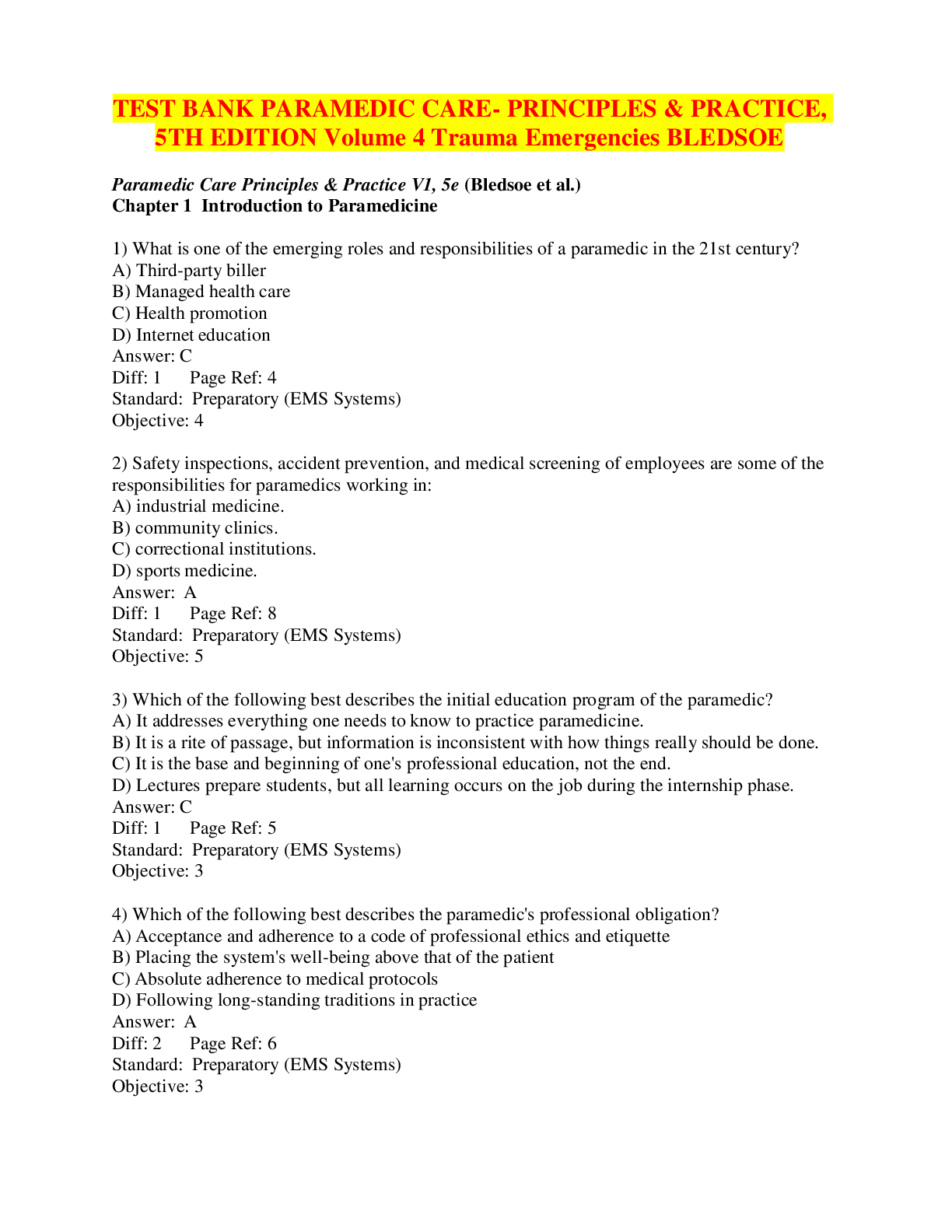



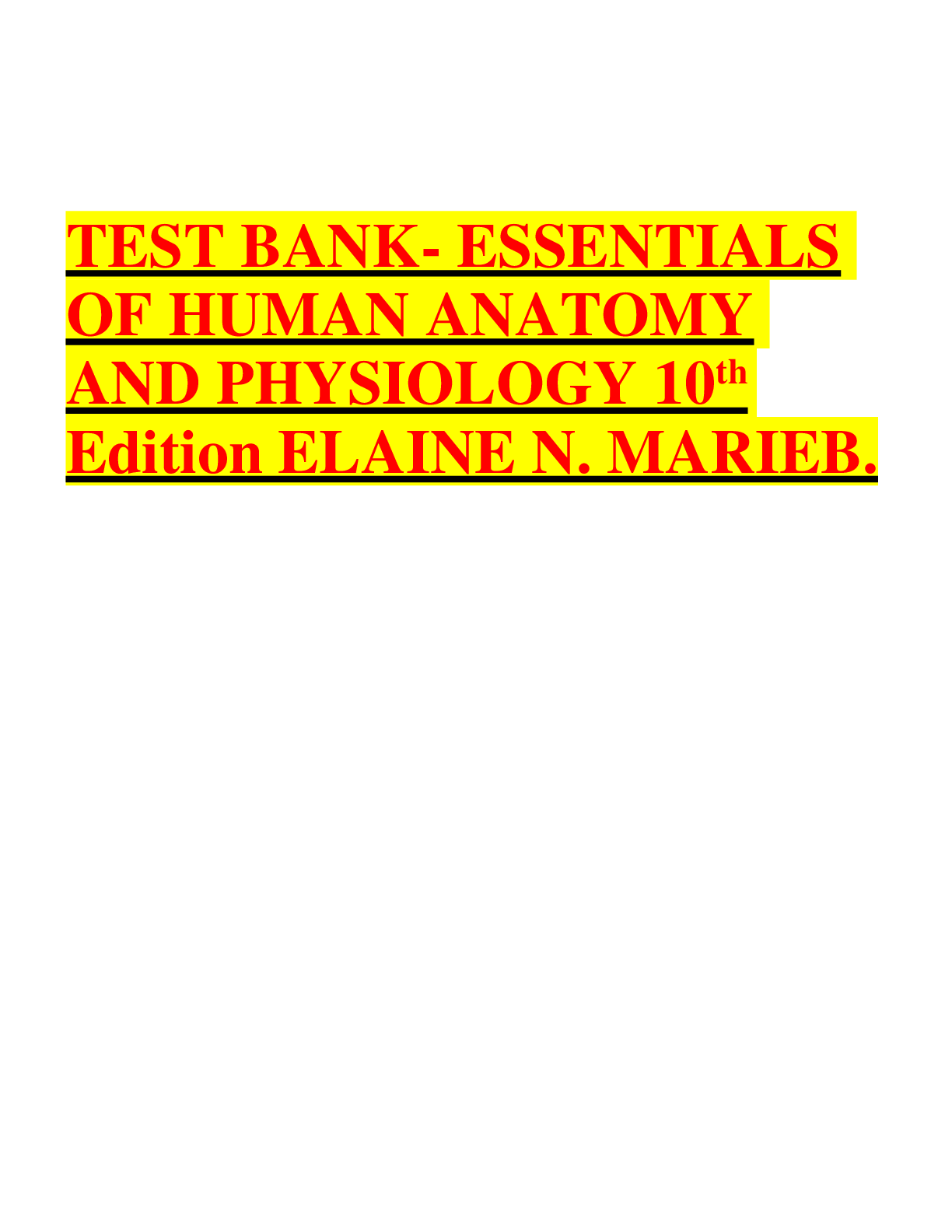

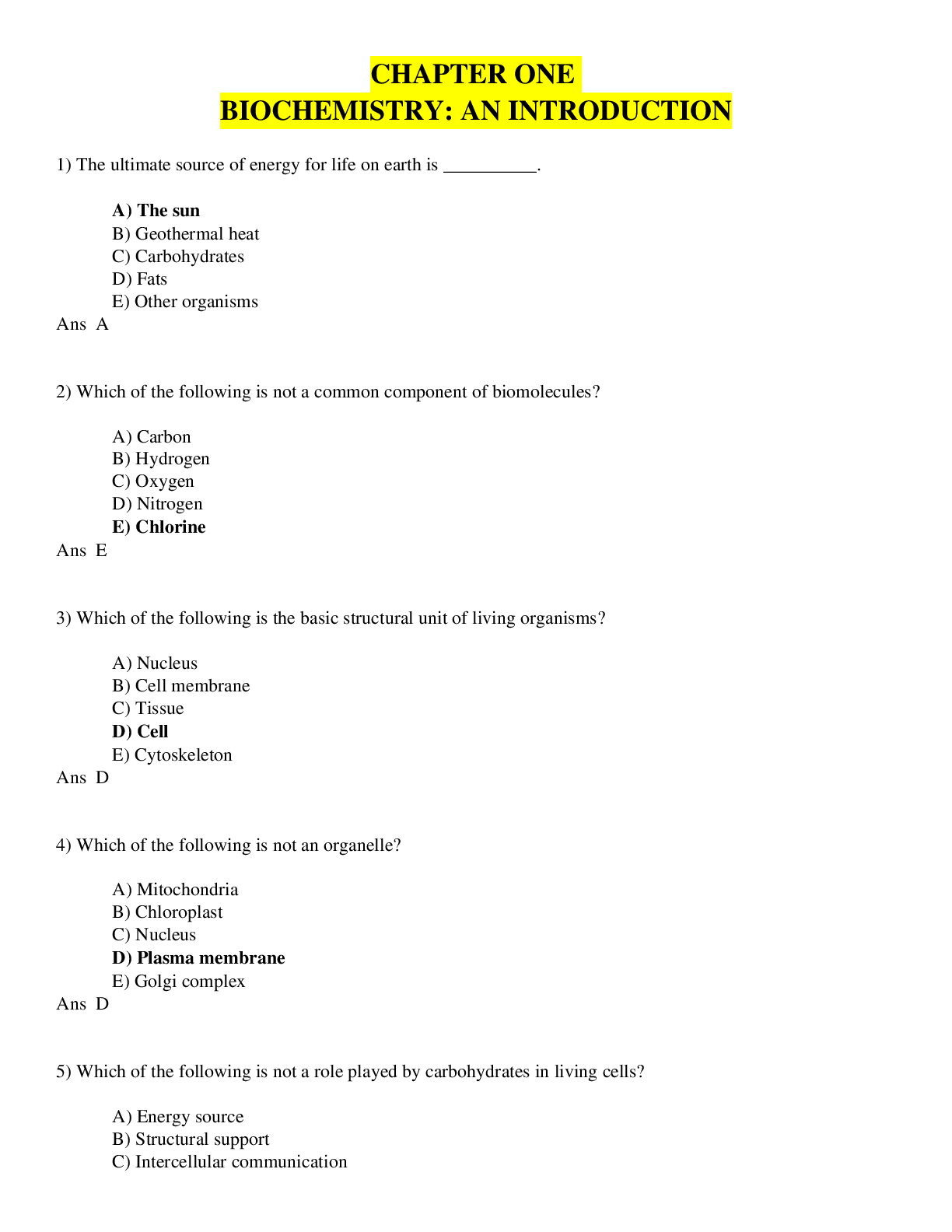
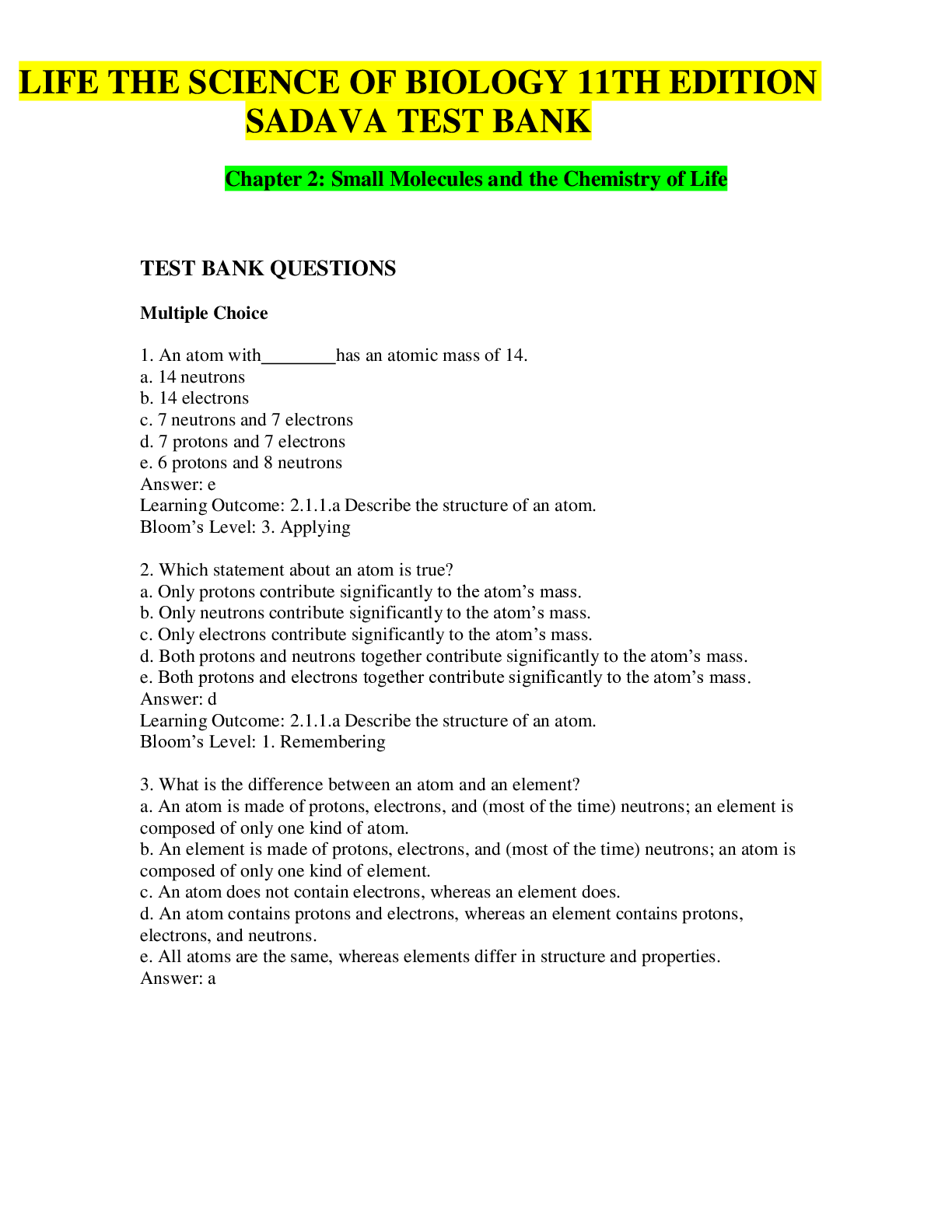
 Test Bank With Rationales.png)


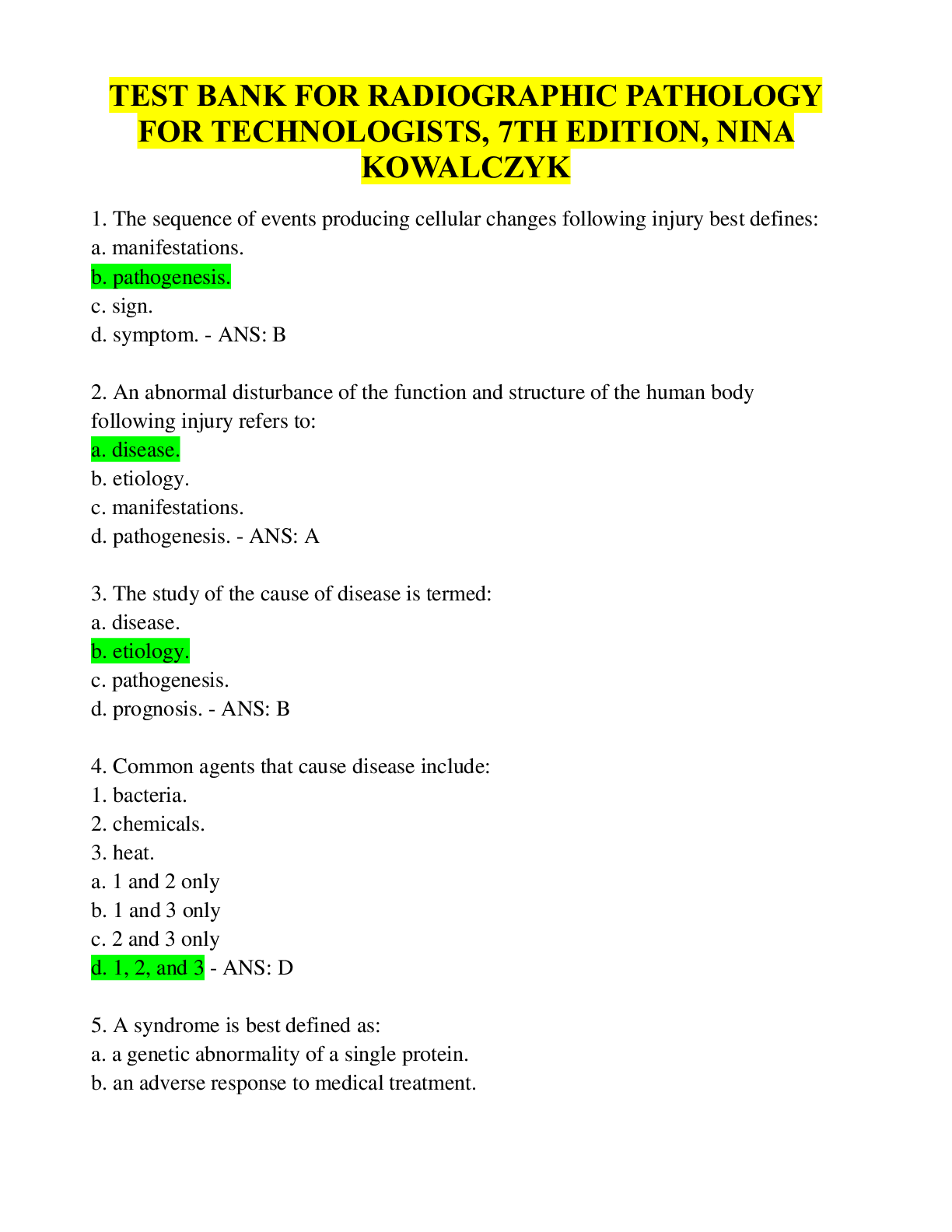

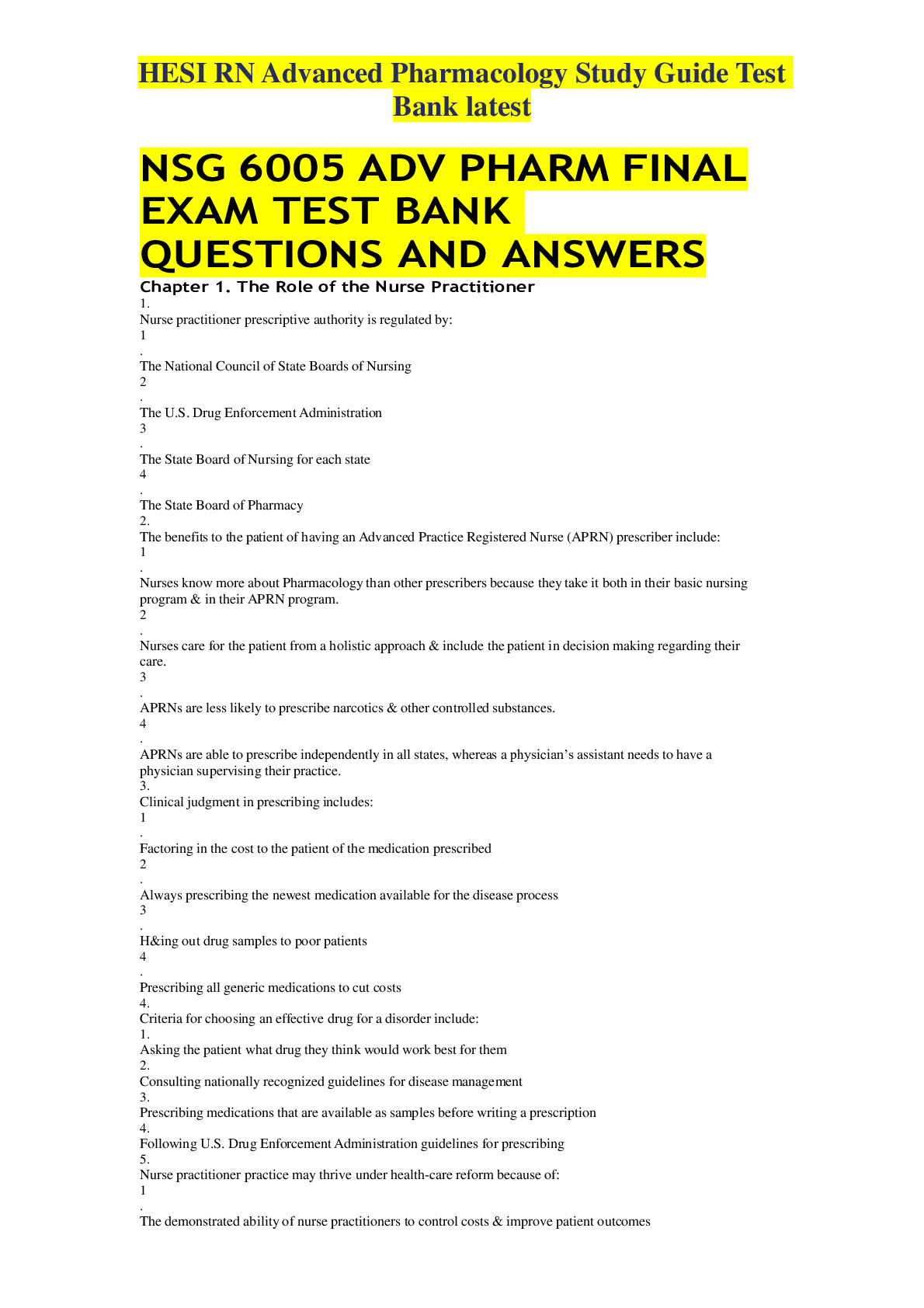
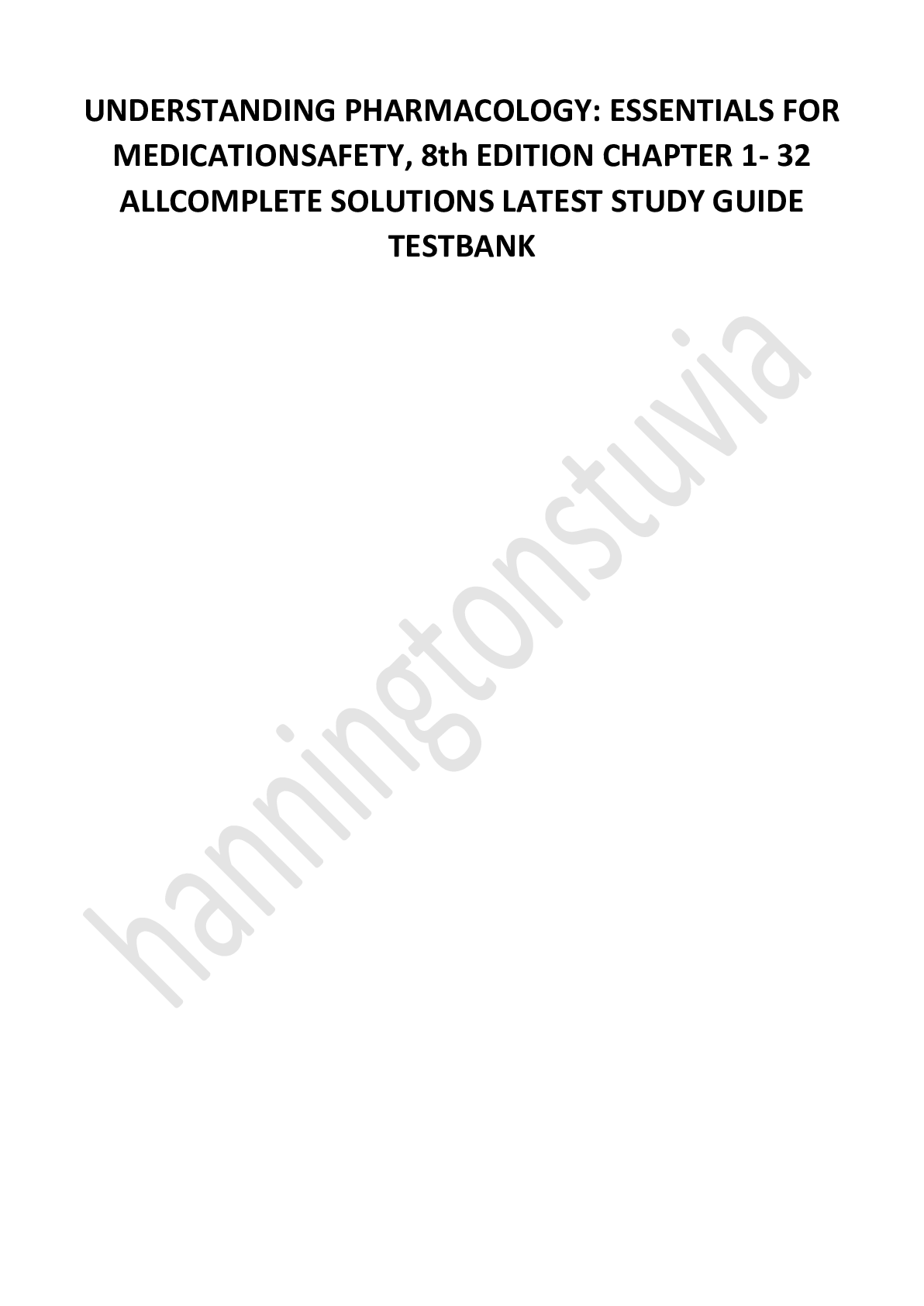
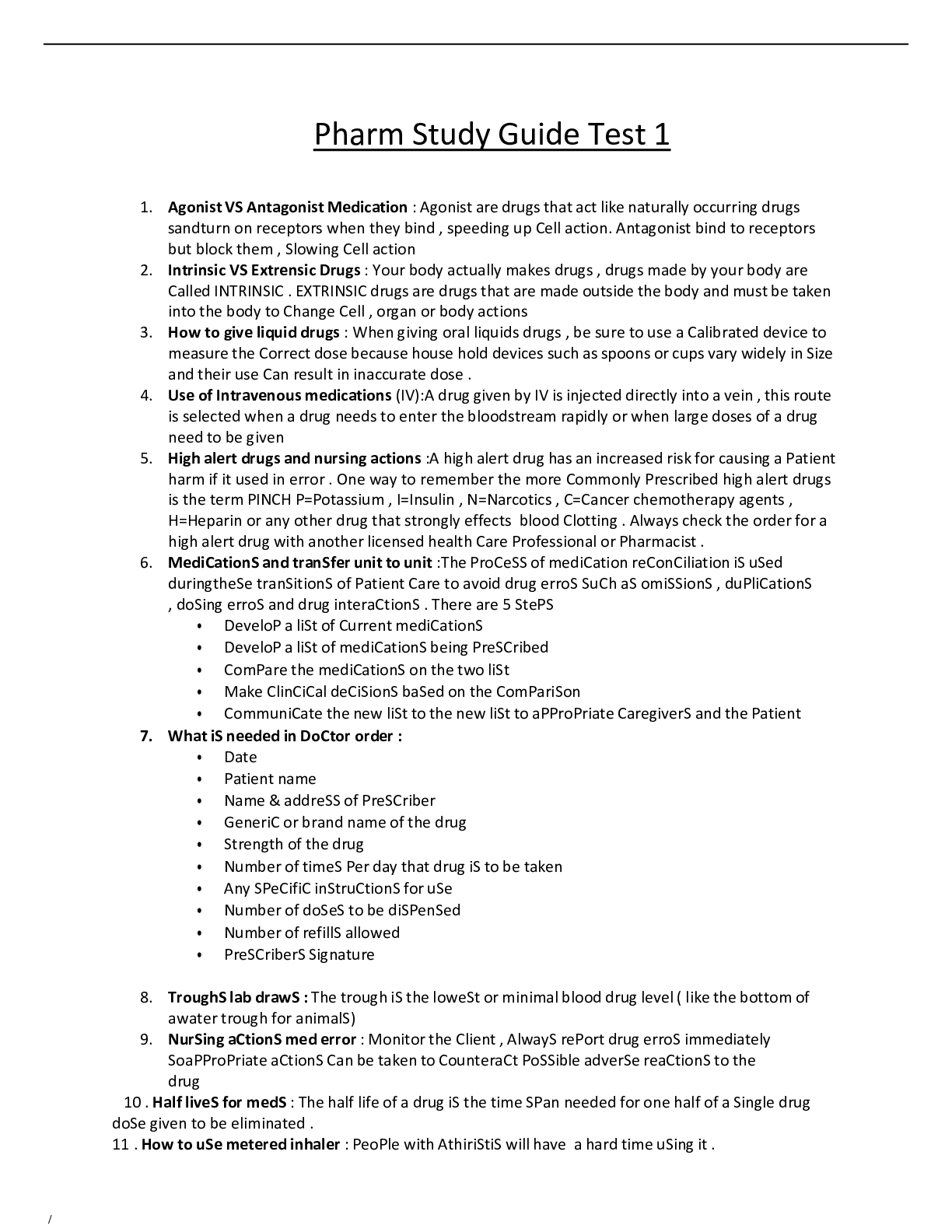
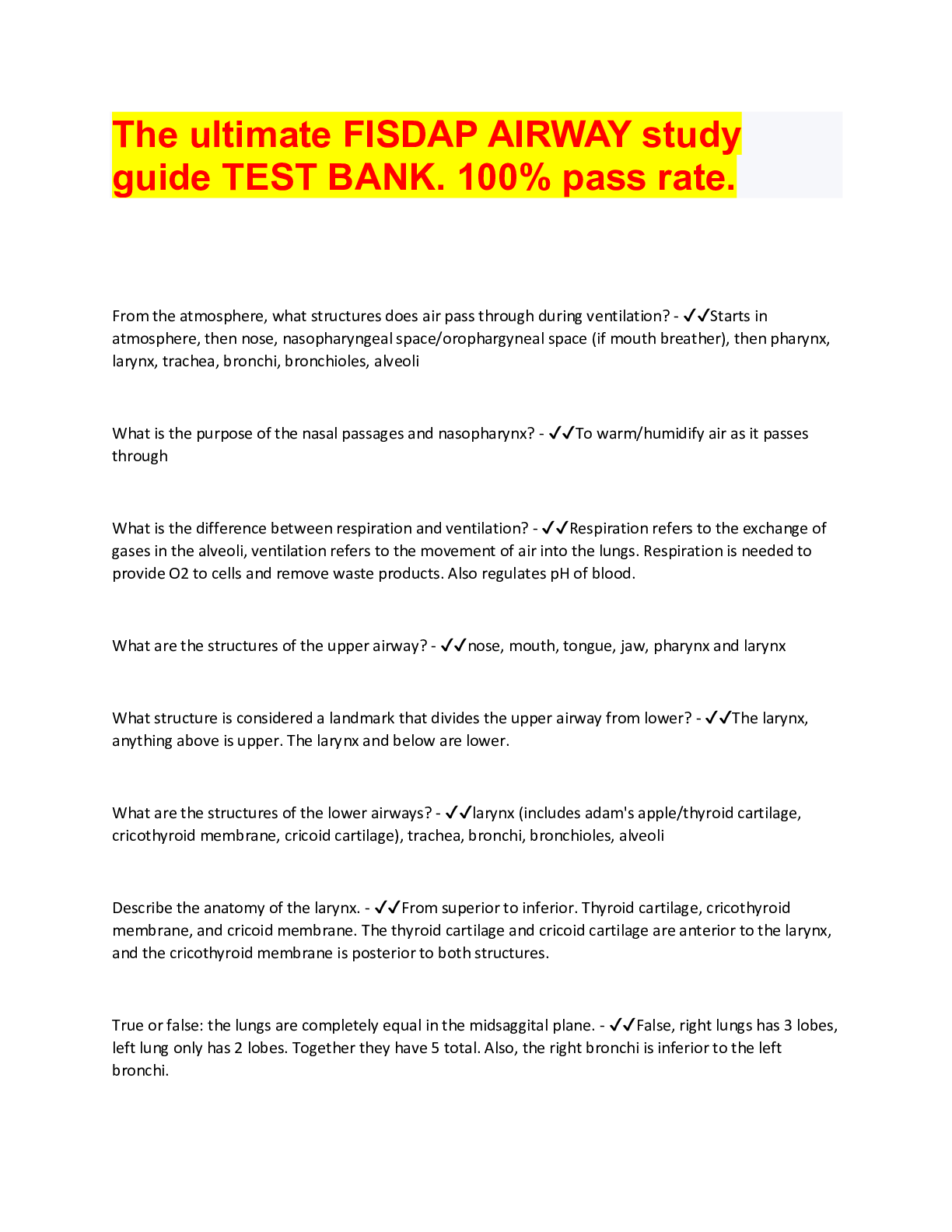

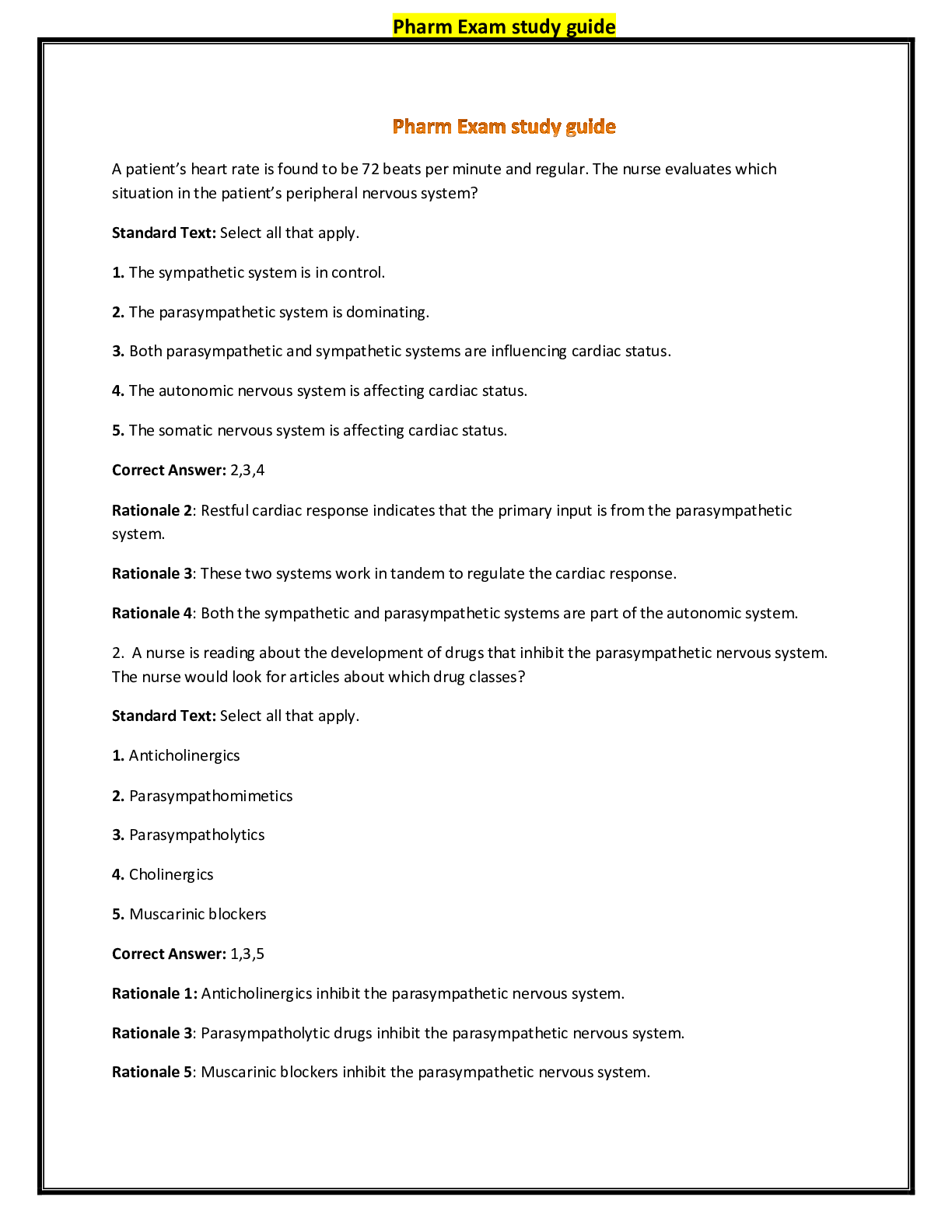
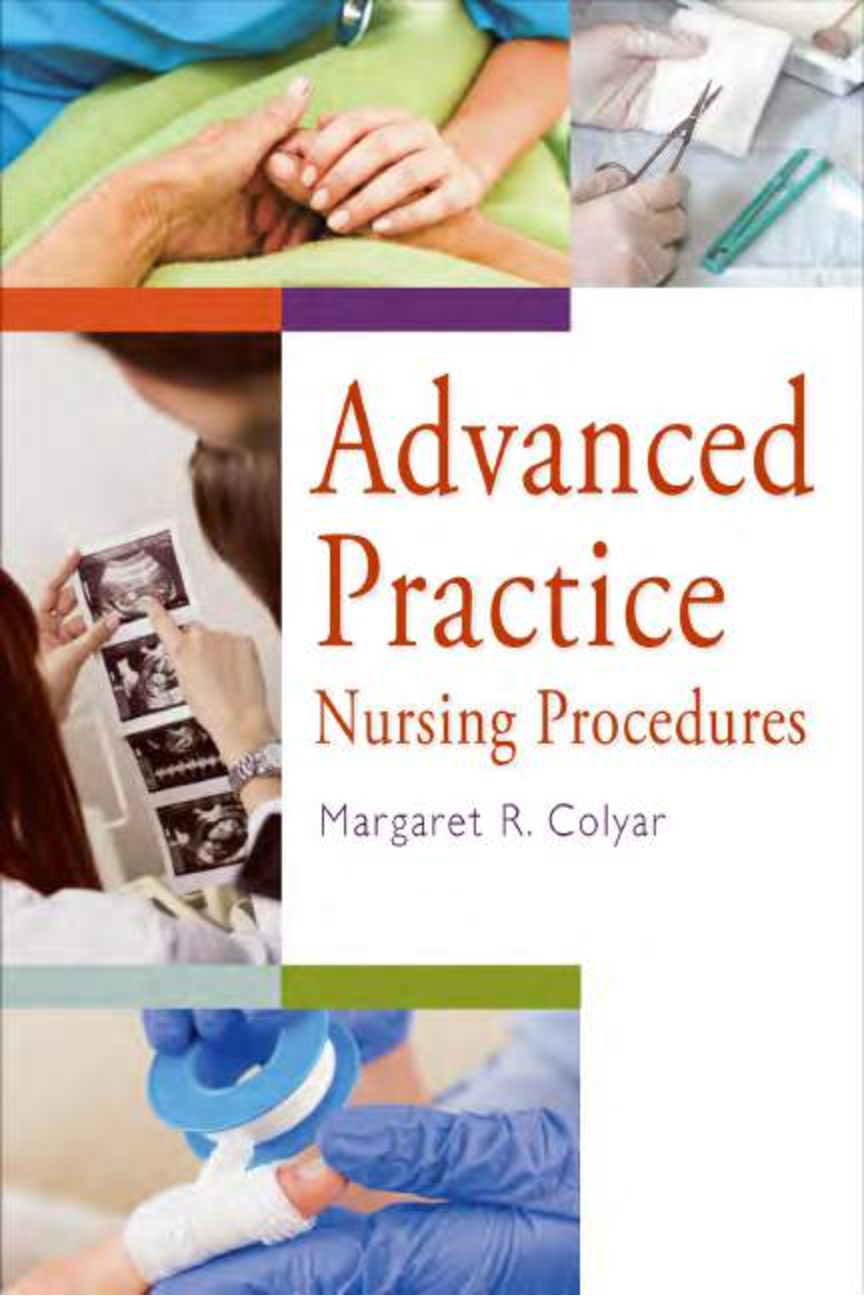

.png)
